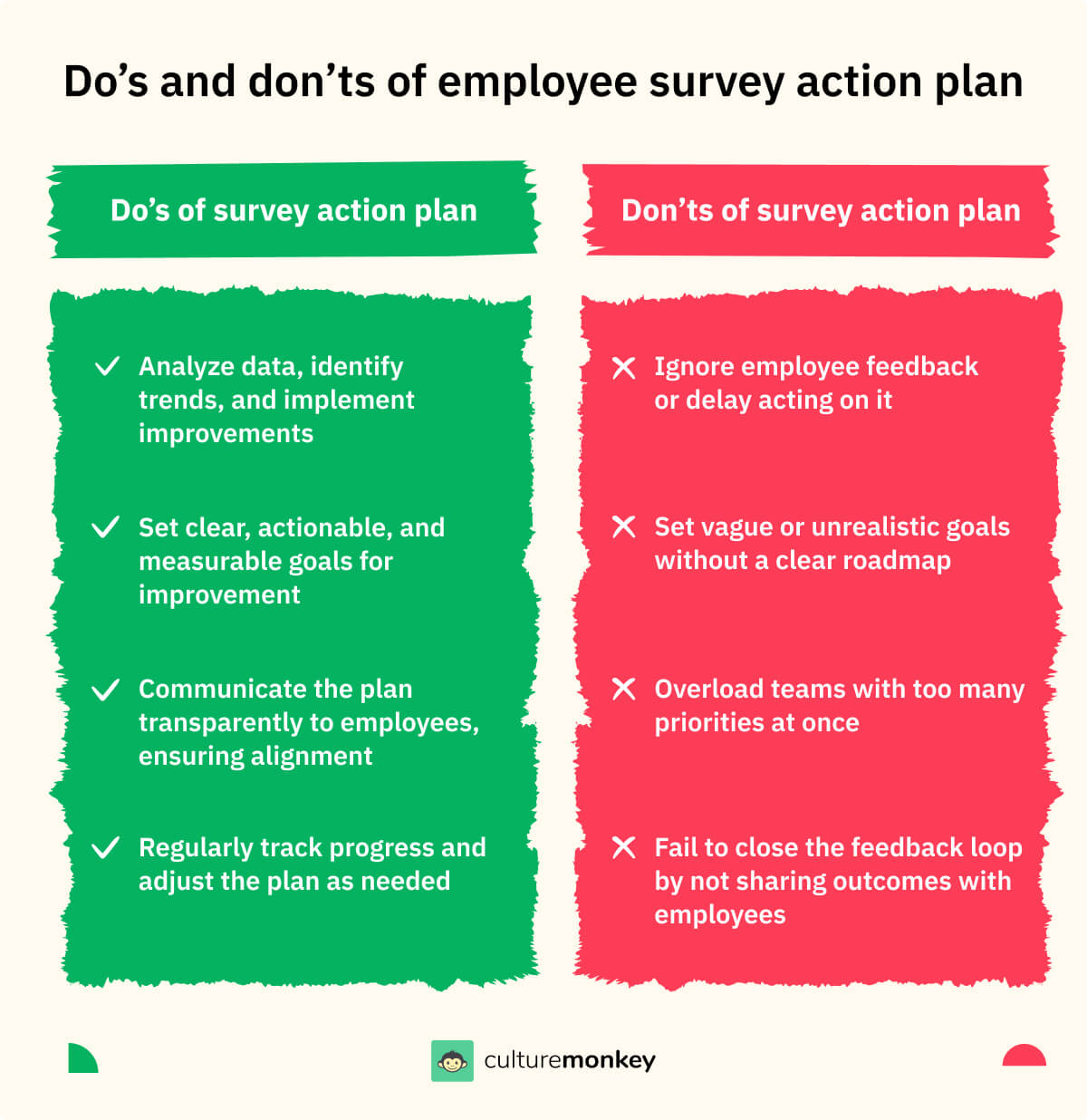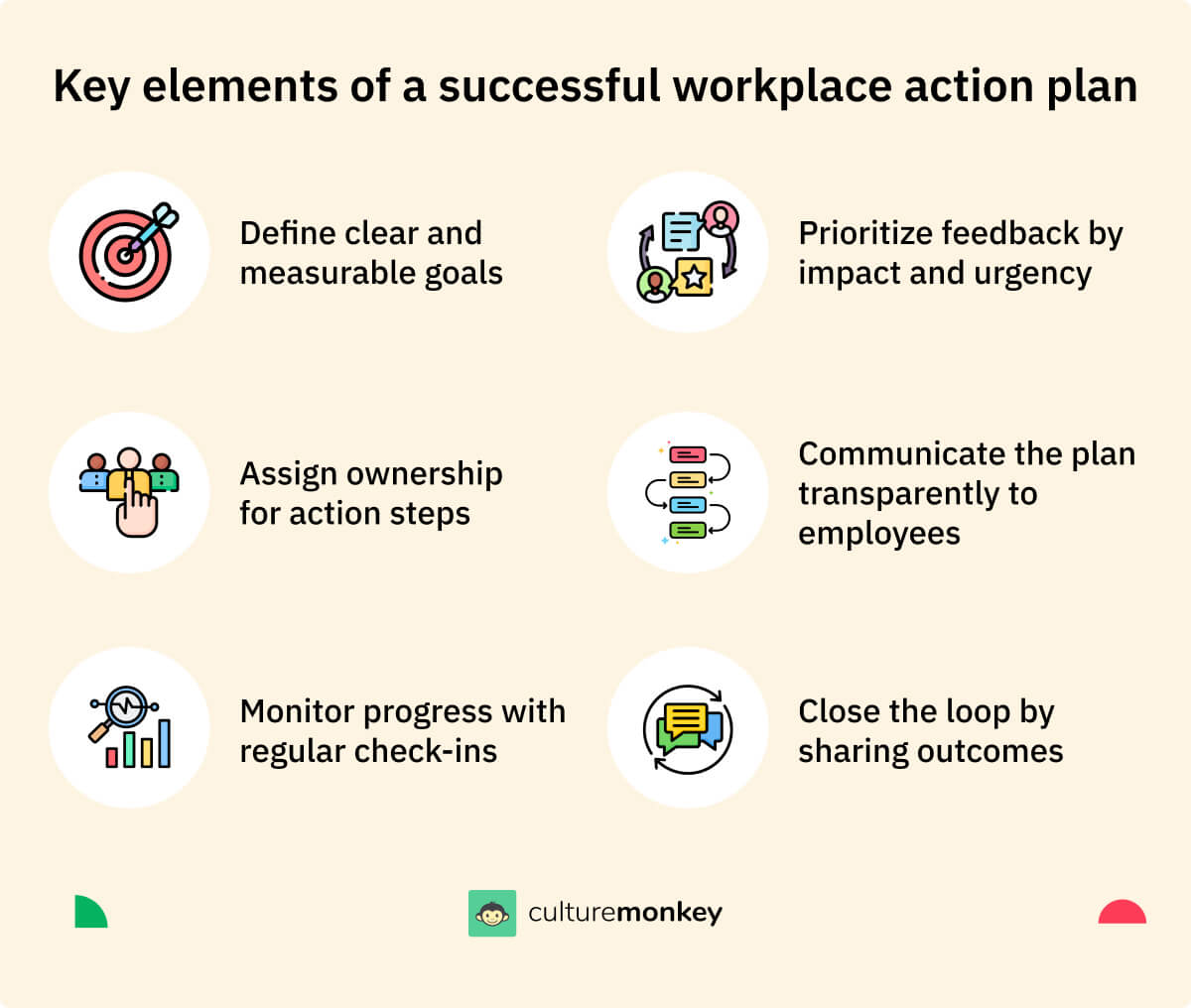How to effectively implement employee engagement survey action plan?

Imagine running a restaurant where diners constantly leave comments about the food being too salty, the service too slow, or the music too loud. Now, picture the chef never adjusting the recipes, the manager ignoring complaints, and the playlist blaring on repeat. What happens?
Customers leave, reviews tank, and the restaurant struggles to stay open. This isn't just a food service issue—it's a mirror for businesses everywhere when feedback is collected but never acted upon. Employees, much like diners, voice their opinions through surveys. But if those insights are ignored, engagement and trust take a nosedive.
Creating an employee survey action plan is like perfecting that restaurant's recipe—listening to what works, addressing what doesn’t, and taking meaningful steps to improve. Ready to cook up a plan that works? Let’s dig in!
Blog Highlights


What is an employee engagement survey action plan?

An employee engagement survey action plan software is a vital tool for addressing concerns raised in employee surveys and boosting overall engagement to achieve business goals. These surveys offer valuable insights into critical areas such as job satisfaction, work environment, leadership, and communication.
The action plan provides a structured approach to addressing these issues, outlining specific steps your company can take to resolve them.
It’s important to note that this plan isn’t a one-time effort. Regular reviews and updates ensure it stays effective and relevant. By consistently acting on employee feedback, companies can create a positive, productive work environment that enhances morale, reduces turnover, and drives business success.



Highly engaged employees make the customer experience. Disengaged employees break it.
Founder and CEO
LeaderFactor
Why create an employee engagement action plan?

Developing an employee engagement action plan is essential for fostering a motivated and committed workforce. Beyond the commonly cited benefits, consider the following advantages:
- Innovation: Engaged employees are more likely to contribute creative ideas, leading to innovative solutions and a competitive edge in the market.
- Employer brand: A robust engagement strategy enhances the organization's reputation, attracting top talent and reducing recruitment costs.
- Absenteeism: Engaged employees tend to have lower absenteeism rates, ensuring consistent productivity and minimizing disruptions.
- Adaptability: A committed workforce is more adaptable to organizational changes, facilitating smoother transitions during restructuring or strategic shifts.
- Employee well-being: Engagement initiatives often address employee well-being, leading to a healthier, more satisfied workforce.
- profitability: Organizations with high engagement levels often experience improved financial performance due to increased productivity and reduced turnover costs.
Benefits of an employee engagement action plan
Developing a comprehensive employee engagement action plan is pivotal for cultivating a motivated and high-performing workforce. Beyond the commonly recognized advantages, consider the following additional benefits:
- Enhanced employee advocacy: Engaged employees are more likely to become brand ambassadors, promoting the organization positively and attracting top talent.
- Improved customer satisfaction: A committed workforce delivers superior service, leading to higher customer satisfaction and loyalty.
- Better health outcomes: Engaged employees often experience lower stress levels, contributing to reduced healthcare costs and absenteeism.
- Increased agility: A highly engaged team is more adaptable, enabling the organization to respond swiftly to market changes and challenges.
- Enhanced corporate social responsibility (CSR): Engaged employees are more likely to participate in CSR initiatives, strengthening the organization's community presence and reputation.
Common challenges in employee survey action plan

Developing an effective employee survey results action plan is essential for enhancing organizational engagement. However, several challenges can impede its success:
- Insufficient leadership commitment: Without strong support from top management, action plans may lack the necessary resources and authority for successful implementation.
- Inadequate training for managers: Managers untrained in executing engagement strategies may struggle with effective implementation, leading to inconsistent outcomes.
- Overlooking individual needs: Applying uniform solutions without considering diverse employee preferences can result in disengagement among certain groups.
- Lack of continuous feedback mechanisms: Failing to establish systems for ongoing feedback prevents timely adjustments, reducing the plan's relevance and impact.
- Unrealistic goal setting: Setting unattainable objectives can demotivate employees and erode trust in the engagement process.

The employee survey action planning process
Developing a comprehensive action plan is essential for translating strategic goals into tangible outcomes. This structured approach ensures that objectives are met efficiently and effectively. Below are key steps to consider in the action planning process:
- Define clear objectives: Begin by articulating specific, measurable, achievable, relevant, and time-bound (SMART) goals. Clear objectives provide direction and a benchmark for success.
- Identify necessary resources: Determine the human, financial, and material resources required to execute each task. Ensuring resource availability is crucial for seamless implementation.
- Assign responsibilities: Delegate tasks to team members based on their skills and expertise. Clearly defined roles enhance accountability and streamline workflow.
- Implement monitoring mechanisms: Set up systems to regularly assess progress against milestones. Ongoing monitoring allows for timely adjustments and keeps the plan on track.
- Review and adjust the plan: Periodically evaluate the action plan's effectiveness and make necessary modifications. Continuous improvement ensures the plan remains aligned with objectives.
- Celebrate achievements: Acknowledge and reward the team's efforts upon reaching milestones. Celebrating success boosts morale and reinforces commitment to organizational goals.
How do you write an action plan for an engagement survey?

Developing a comprehensive employee engagement plan is essential for fostering a motivated and productive workforce. Beyond standard practices, consider the following strategies to enhance your plan:
- Align engagement initiatives with organizational values: Ensure that engagement activities reflect and reinforce your company's core values. This alignment fosters a sense of purpose and belonging among employees, enhancing their connection to the organization.
- Facilitate cross-departmental collaboration: Encourage teamwork across different departments to break down silos and promote knowledge sharing. This approach not only enhances engagement but also drives innovation and a unified company culture.
- Provide opportunities for skill diversification: Offer employees the chance to explore roles or projects outside their usual responsibilities. This diversification can reignite passion and uncover hidden talents, contributing to personal growth and organizational success.
- Implement a mentorship program: Pair experienced employees with newer team members to facilitate knowledge transfer and career development. Mentorship fosters a supportive environment, enhancing engagement and retention.
- Encourage employee autonomy: Empower employees to make decisions within their roles. Autonomy enhances job satisfaction and demonstrates trust in their capabilities, leading to higher engagement levels.
Typical mistakes HR makes in action planning

HR departments often encounter pitfalls that can undermine these efforts. 7 Key mistakes include:
- Lack of alignment with organizational goals: HR strategies sometimes operate in isolation, failing to integrate with the company's overarching objectives. This misalignment can lead to initiatives that don't support the organization's mission or vision.
- Overcomplicating processes: Introducing overly complex procedures can hinder employee participation and understanding. Simplicity and clarity are essential to ensure that action plans are accessible and executable.
- Inadequate documentation: Failing to maintain accurate records of employee performance and HR activities can result in legal issues and hinder decision-making. Implementing a robust system for up-to-date record-keeping is essential.
- Neglecting employee engagement: Overlooking the importance of employee engagement can lead to decreased productivity and higher turnover rates. HR should implement strategies that promote regular communication, recognition, and career development opportunities.
- Planning in isolation: Developing HR strategies without input from other departments can result in plans that lack support and relevance. Collaborative planning ensures that initiatives are comprehensive and widely endorsed.
- Failure to update policies: Outdated HR policies can lead to inconsistencies and legal challenges. Regularly reviewing and updating policies ensures compliance and relevance.
- Poor hiring practices: Inadequate hiring processes can result in poor team dynamics and increased turnover. Establishing a thorough hiring process, including detailed job descriptions and comprehensive interviews, is crucial.
Employee engagement action plan ideas

Developing a comprehensive employee engagement action plan is essential for fostering a motivated and productive workforce. Beyond standard practices, consider implementing the following innovative ideas:
- Establish a reverse mentoring program: Pair junior employees with senior leaders to mentor them on emerging technologies, current trends, and new perspectives. This initiative promotes mutual learning and bridges generational gaps within the organization.
- Introduce silent meetings: Conduct meetings where participants communicate through written means, such as shared documents or chat platforms, to encourage thoughtful contributions and reduce interruptions. This approach can lead to more inclusive and productive discussions.
- Implement a 'Season of giving' initiative: Encourage employees to propose and participate in projects that contribute positively to society, fostering a sense of purpose and community involvement. This not only enhances engagement but also strengthens the organization's social responsibility.
- Offer personalized coaching opportunities: Provide access to personalized coaching for all employees, not just senior executives, to support their professional development and address individual challenges. This investment demonstrates a commitment to employee growth and well-being.
- Facilitate cross-functional shadowing: Allow employees to spend time shadowing colleagues in different departments to gain a broader understanding of the organization and identify potential areas for collaboration and career development.
- Create innovation labs: Establish dedicated spaces where employees can experiment with new ideas and technologies, fostering a culture of innovation and continuous improvement.
- Implement a 'Bring your passion to work' program: Encourage employees to dedicate a portion of their work time to projects they are passionate about, which can lead to increased motivation and the discovery of new business opportunities.
- Conduct stay interviews: Regularly engage with current employees to understand their motivations and address any concerns, proactively improving retention and satisfaction.
Employee engagement action plan examples

Here are some examples of how to create an effective employee engagement action plan:
Airbnb – Championing company culture
Airbnb places a strong emphasis on aligning employees with its mission of “belonging anywhere.” Through initiatives like its "One Airbnb" global meetups and employee-driven resource groups, the company fosters a sense of community and shared purpose. This alignment with a clear mission has been pivotal in keeping employees engaged and connected.
Adobe – Removing annual performance reviews
Adobe replaced traditional annual performance reviews with "Check-ins," an ongoing feedback system. Managers and employees have regular conversations about goals and performance, creating a culture of transparency and continuous improvement. This shift has significantly enhanced employee satisfaction and productivity.
Zappos – Emphasizing personal development
Zappos invests heavily in personal growth by offering employees opportunities for training and development outside their immediate roles. The company even provides financial incentives for completing courses and certifications. This focus on employee development strengthens engagement and encourages long-term retention.
Action planning methods for your engagement survey results

Here are a few methods for prioritizing issues and developing your action plan:
- Pareto Analysis: Use the Pareto principle to focus on the 20% of issues causing 80% of the problems. Identify critical concerns and prioritize resources to address these high-impact areas effectively.
- Impact vs. Effort: Prioritize issues based on their impact on engagement and the effort needed to address them. Focus on high-impact, low-effort concerns first to maximize results efficiently.
- Employee Input: Survey employees again to prioritize the most pressing issues identified earlier. Involving them in the process fosters engagement and ensures the action plan addresses their key concerns.
- SWOT Analysis: Conduct a SWOT analysis using survey results to pinpoint strengths, weaknesses, opportunities, and threats. This method provides a balanced perspective on organizational challenges and improvement areas.
- Themed Action Groups: Form groups from various departments to tackle specific issues, like "Work-Life Balance." Diverse perspectives and collaboration create actionable solutions and increase organizational buy-in.
- Root Cause Analysis (RCA): Investigate underlying reasons for key issues using RCA. For example, low morale could stem from unclear communication or lack of recognition, leading to targeted and effective solutions.
- Set SMART Goals: Develop Specific, Measurable, Achievable, Relevant, and Time-bound goals. For instance, introduce three training programs within six months to address professional development concerns.
- Feedback Loops: Regularly update employees on progress and outcomes of action items. Transparent communication builds trust and reinforces the value of their feedback in the improvement process.
How to review your employee engagement survey results?
Reviewing your employee engagement survey results and action plan is the first step in creating an actionable plan for improving staff engagement. Follow these steps for reviewing your employee engagement survey results:
- Determine your desired outcomes: Define your goals and objectives in terms of employee engagement and how they align with your organization's values, culture, and operations.
- Review your survey data: Analyze the data to identify insights, trends, and opportunities for improvement.
- Benchmark: Compare your results with industry benchmarks or other organizations similar to yours.
- Identify key themes: Identify common themes and issues to address in the action plan.
- Prioritize issues: Prioritize issues based on their significance and strategic impact on your organization, and prioritize addressing those issues first.
Measuring the success of your action plan

Measuring the success of an action plan is essential to ensure that organizational objectives are met effectively. Implementing systematic evaluation methods provides clarity on progress and areas for improvement. Consider the following strategies:
- Establish key performance indicators (KPIs): Identify quantifiable metrics that align with your objectives to monitor progress and performance accurately.
- Set baseline data: Determine current performance levels before implementing the action plan to measure growth and impact effectively.
- Regular monitoring and reporting: Utilize project management tools to track ongoing progress and generate reports that facilitate timely decision-making.
- Gather stakeholder feedback: Engage employees and other stakeholders to obtain qualitative insights into the action plan's effectiveness and areas needing adjustment.
- Conduct periodic reviews: Schedule regular assessments to compare outcomes against set objectives, allowing for necessary recalibrations.
- Document lessons learned: Record successes and challenges encountered during implementation to inform future action plans and promote continuous improvement.
Conclusion
Creating an employee survey action plan is vital for building a thriving and engaged workforce. By turning employee feedback into actionable strategies, organizations can address concerns, up performance metrics boost morale, and improve productivity.
CultureMonkey’s innovative platform is designed to help companies improve survey participation rates and gather real-time employee feedback. With its user-friendly interface and customizable surveys, CultureMonkey makes the process a breeze for both administrators and employees.
What sets CultureMonkey apart is its focus on continuous improvement. It doesn't just stop at gathering employee feedback; it provides actionable insights and recommendations to help you drive positive change within your organization.
Plus, with its real-time reporting and analytics, you can track progress and make data-driven decisions that have a tangible impact on your company's culture and bottom line.
Let CultureMonkey help you take employee engagement efforts to the next level—turn ideas into actions that matter.
Summary
Employee survey action plans are essential for turning feedback into meaningful change. By analyzing survey results and prioritizing key areas, organizations can create actionable strategies to address employee concerns and improve engagement.
This structured approach ensures accountability, fosters trust, and demonstrates a commitment to employee well-being. Effective action plans not only boost satisfaction and retention but also drive organizational growth by creating a more motivated and aligned workforce.
FAQs
1. Who is responsible for employee engagement action planning?
HR leaders typically take the lead in employee engagement action planning, but it’s a shared responsibility. Managers play a critical role in implementing changes within their teams, while senior leaders ensure alignment with organizational goals. Involving employees themselves in the process can foster ownership and increase the plan’s effectiveness, creating a collaborative effort for meaningful outcomes.
2. What should you do with employee survey results?
Start by analyzing survey results to identify key patterns and areas for improvement. Share the findings with employees transparently to demonstrate accountability. Prioritize actionable insights and use them to create a detailed engagement action plan. Follow up with updates on progress and specific changes being implemented to build trust and reinforce the value of employee feedback.
3. How do you prioritize issues identified in survey feedback?
Prioritize issues using methods like Impact vs. Effort, focusing on problems with the highest impact and manageable effort. Address immediate concerns affecting morale or productivity first. Actively engage employees in prioritization to understand their most pressing needs. Balance short-term wins with long-term strategies to ensure sustainable improvements while addressing critical organizational challenges and fostering a positive workplace culture.
4. What should you do if employees don’t see changes from the action plan?
Communicate updates regularly, even for small wins, to showcase progress and maintain trust. Address challenges transparently and share realistic timelines for ongoing initiatives. Seek feedback to understand gaps between expectations and actions. Continuously adjust strategies to improve visibility, communication, and effectiveness, ensuring employees feel their concerns are addressed, valued, and integrated into actionable plans driving meaningful change and engagement.
5. How often should you revisit and update your action plan?
Revisit the action plan every quarter to assess progress and make necessary adjustments for continuous improvement. Conduct comprehensive reviews annually, especially after engagement surveys, to realign the plan with current employee needs and expectations. Frequent updates ensure the plan remains relevant, actionable, and impactful, maintaining momentum, employee trust, and alignment with organizational goals throughout the process.




